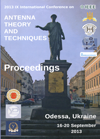Upgrades to the Kharkiv V. N. Karazin National University MF radar antenna
DOI:
https://doi.org/10.1109/ICATT.2013.6650781Keywords:
medium frequency radar antenna, antenna array, loaded antenna, multifrequency antennaAbstract
The Kharkiv V. N. Karazin National University MF radar has been widely employed to study mesospheric electrodynamics in the altitude range from 60 to 70 km where the electron density values remain below 100 cm–3. On the other hand, the technique developed at the University for investigating mesospheric electrodynamics demands signal-to-noise ratios greater than five. In addition, a major contribution to signal degradations makes radio interference, and consequently the radar has to operate in a frequency range at the upper end of the medium frequency band, and the antenna array cannot be designed to be resonant. The purpose of this article is to report the upgrades to the MF radar antenna array to achieve maximum signal-to-noise ratio values. First, the replacement of a point resistive load by a resistor-capacitor load has provided the improvement in the impedance match of the existing antenna to the feeder. The voltage standing wave ratio in the 1.9–3 MHz frequency band could reach 3 before the replacement and does not exceed a value of 1.75 thereafter. Further, the upgrades put forward to the individual antenna arrangement resulted in converting three-lobe antenna pattern only into one-lobe symmetric antenna pattern and low levels of sidelobes over the entire 1.5–3.5 MHz frequency band.References
MANSON, A.H.; MEEK, C.E.; MARTYNENKO, S.I.; ROZUMENKO, V.T.; TYRNOV, O.F. VLF Phase Perturbations Produced by the Variability in Large (V/m) Mesospheric Electric Fields in the 60-70 km Altitude Range. Meeting Proc. RTO-MP-IST-056, Neuilly-sur-Seine, France, 2006, p.8-1-8-24.
GARDNER, F.F.; PAWSEY, J.L. Study of the ionospheric D-region using partial reflections. J. Atm. Terr. Phys., 1953, v.3, p.321-344, doi: http://dx.doi.org/10.1016/0021-9169(53)90084-1.
BELROSE, J.S.; BURKE, M.J. A study of the lower ionosphere using partial reflections. 1 Experimental technique and method of analysis. J. Geophys. Res., 1964, v.69, p.2799-2818, doi: http://dx.doi.org/10.1029/JZ069i013p02799.
TYRNOV, O.F.; GARMASH, K.P.; GOKOV, A.M.; GRITCHIN, A.I.; DOROHOV, V.L.; KONTZEVAYA, L.G.; KOSTROV, L.S.; LEUS, S.G.; MARTYNENKO, S.I.; MISYURA, V.A.; PODNOS, V.A.; POKHILKO, S.N.; ROZUMENKO, V.T.; SOMOV, V.G.; TSYMBAL, A.M.; CHERNOGOR, L.F.; SHEMET, A.S. The Radiophysical Observatory for Remote Sounding of the Ionosphere. Turkish Journal of Physics, 1994, v.18, p.1260-1265.
GONCHARENKO, I.V. Antenna Computer Simulation. Everything About the "MMANA" Program. Radio Journal, 2002.
YATSKEVICH, V.A. Log-periodic vibrator antennas and their computer aided design. Radio Journal, 2006, n.2, p.8-10.
OVSYANNIKOV, V.V. On the design of pin and folded vibrator antennas with series point loads. Antennas, 1984, n.31, p.88-104.

